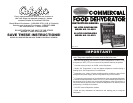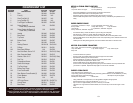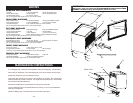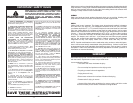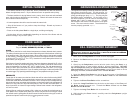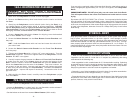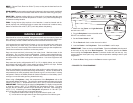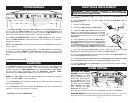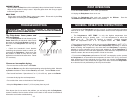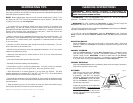
-5-
-16-
1. Make sure the Dehydrator is turned off and unplugged.
2. Remove the Racks and any other loose items from the interior and close
the Door.
3. Gently lay the Dehydrator onto its left side (when facing the Door) on a
rug, folded blanket or other similar article to prevent scratching. DO NOT
lay the Dehydrator onto its right side because the glass Door may fall
open and break! DO NOT lay the Dehydrator onto its front or back to avoid
damaging the Door, Control Panel and/or Circuit Breaker.
4. Insert the Short Foot Bolts into the holes at the bottom of the Feet until
the Bolts threads protrude out. Thread the Bolts & Feet into the Front Foot
Brackets.
5. Tighten the Short Foot Bolts with a screwdriver.
6. Insert the Long Foot Bolts into the holes at the bottom of the Feet until
the Bolts threads protrude out. Thread the Bolts & Feet into the Rear
Bottom Corner Brackets.
7. Tighten the Long Foot Bolts with a screwdriver.
8. While holding the Door closed, carefully stand the Dehydrator upright
onto the Feet.
80-L DEHYDRATOR ASSEMBLY
WARNING! Before cleaning, assembling or disassembling the
Dehydrator, make sure the Dehydrator is OFF and the PLUG IS REMOVED
FROM THE OUTLET/POWER SOURCE!
This appliance must be grounded to protect the operator
from electric shock during use. For this purpose, it is
equipped with a three-conductor power cord and three-
prong grounding-type plug (Figure A). The plug only ts
three-hole electric receptacles. For the plug to t a
two-hole receptacle, you will need a Grounding Plug
Adapter with a wire or metal tab (Figure B). Connect
the wire/tab to the electrical outlet with the cover plate
screw. The screw must be metal. The electrical box
must be properly grounded (Figure C).
GROUNDING INSTRUCTIONS
Figure A
Figure C
Figure B
3-Hole
Electrical
Receptacle
Grounding
Type Plug
Grounding
Plug Adapter
Metal Tab
or Wire
3-Hole
Electrical
Receptacle
FOOD SAFETY
There are basic rules to follow when handling food.
They are COOK, SEPARATE, CLEAN, and CHILL.
COOK
It’s crucial to cook food to a safe internal temperature to destroy bacteria that is present.
The safety of hamburgers and other foods made with ground meat has been receiving a
lot of attention lately, and with good reason. When meat is ground, the bacteria present
on the surface is mixed throughout the ground mixture. If this ground meat is not cooked
to at least 160
o
F to 165
o
F (71
o
C to 74
o
C), bacteria will not be destroyed and there’s a
good chance you will get sick.
Solid pieces of meat like steaks and chops don’t have dangerous bacteria like E. coli on
the inside, so they can be served more rare. Still, any beef cut should be cooked to an
internal temperature of at least 145
o
F (63
o
C) (medium rare). The safe temperature for
poultry is 180
o
F (82
o
C) and solid cuts of pork should be cooked to 160
o
F (71
o
C). Eggs
should be thoroughly cooked too. If you are making a meringue or other recipe that uses
uncooked eggs, buy specially pasteurized eggs or use prepared meringue powder.
SEPARATE
Foods that will be eaten uncooked and foods that will be cooked before eating MUST
ALWAYS be separated. Cross-contamination occurs when raw meats or eggs come in
contact with foods that will be eaten uncooked. This is a major source of food poisoning.
Always double-wrap raw meats and place them on the lowest shelf in the refrigerator so
there is no way juices can drip onto fresh produce. Then use the raw meats within 1-2
days of purchase, or freeze for longer storage. Defrost frozen meats in the refrigerator,
not on the counter.
When grilling or cooking raw meats or sh, make sure to place the cooked meat on a
clean platter. Don’t use the same platter you used to carry the food out to the grill. Wash
the utensils used in grilling after the food is turned for the last time on the grill, as well as
spatulas and spoons used for stir-frying or turning meat as it cooks.
DRYING FLOWERS
• The owers should be dry to start with, best if picked after the dew has dried and
before the night damp sets in. Dry the owers as soon as possible after picking.
• The best condition for drying owers is a dry, warm, dark, clean and well ventilated
area, which makes a dehydrator an ideal setting. Flowers will retain the best color
and condition when dried quickly.
• A low temperature should be used to retain the natural oils.
• Strip off the leaves or if you prefer to keep the foliage. Discard any brown or
damaged leaves.
• Place on the dehydrator Rack in a single layer, avoiding overlapping.
• Drying times will vary considerably depending on the size of the ower and the
amount of foliage. Dry at 100°F (38°C).



